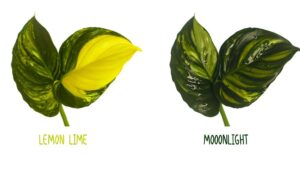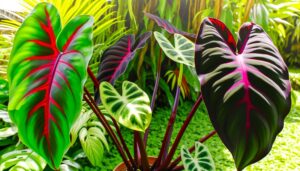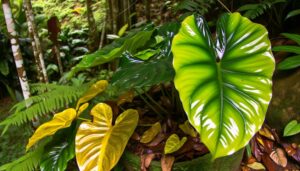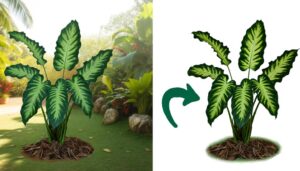Heartleaf Philodendron Vs Pothos: A Detailed Comparison!
Heartleaf Philodendron (Philodendron hederaceum) and Pothos (Epipremnum aureum) are distinct aroids. Philodendron leaves are heart-shaped, smooth, and 2-4 inches long, while Pothos leaves reach up to 12 inches, with a leathery texture and variegation.
Philodendron’s slender stems and frequent aerial roots contrast with Pothos’s thick, robust stems and less frequent aerial roots. Philodendron thrives in low to medium light, preferring consistently moist soil, whereas Pothos is resilient in low-light and is more drought-tolerant.
Each plant’s unique characteristics have implications for care and cultivation. To explore these intricate differences further, engaging with detailed information is beneficial.
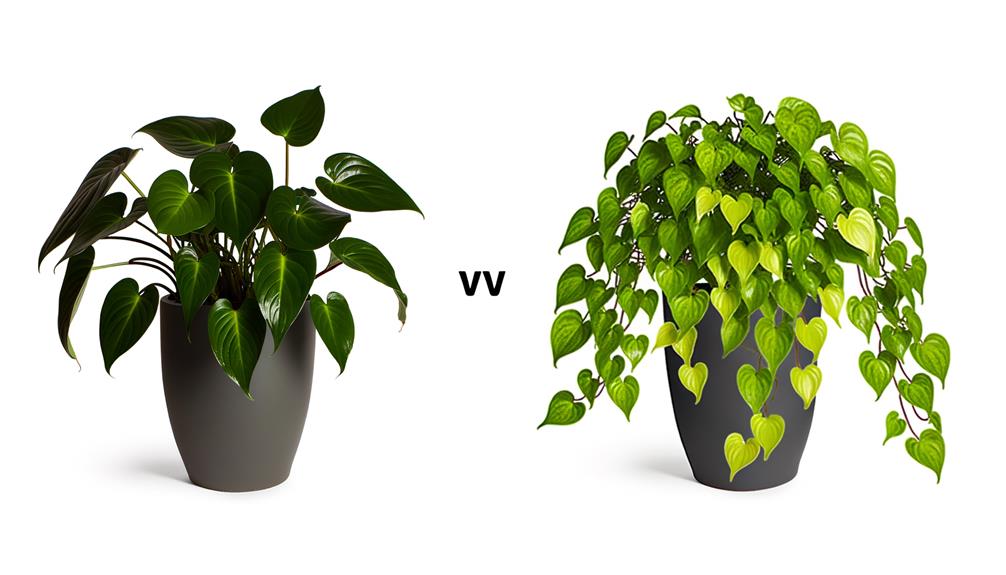
Comparison of Heartleaf Philodendron and Pothos
| Feature | Heartleaf Philodendron | Pothos (Epipremnum aureum) |
|---|---|---|
| Common Name | Heartleaf Philodendron | Pothos, Devil’s Ivy |
| Botanical Name | Philodendron hederaceum | Epipremnum aureum |
| Leaf Appearance | Heart-shaped, glossy green leaves | Heart-shaped leaves, various variegations including green, yellow, white, and cream |
| Growth Habit | Climbing or trailing vine | Climbing or trailing vine |
| Light Requirements | Low to bright, indirect light | Low to bright, indirect light |
| Watering Needs | Moderate, allow the top inch to dry out | Moderate, allow the top inch to dry out |
| Humidity Preference | Medium to high humidity | Medium humidity |
| Temperature Tolerance | 65-80°F (18-27°C) | 60-85°F (15-29°C) |
| Soil Type | Well-draining, aroid mix | Well-draining, general-purpose potting mix |
| Fertilization | Monthly during growing season | Monthly during growing season |
| Propagation Methods | Stem cuttings in water or soil | Stem cuttings in water or soil |
| Pest Susceptibility | Spider mites, mealybugs, aphids | Spider mites, mealybugs, scale |
| Toxicity | Toxic to pets and humans | Toxic to pets and humans |
Origin and Habitat
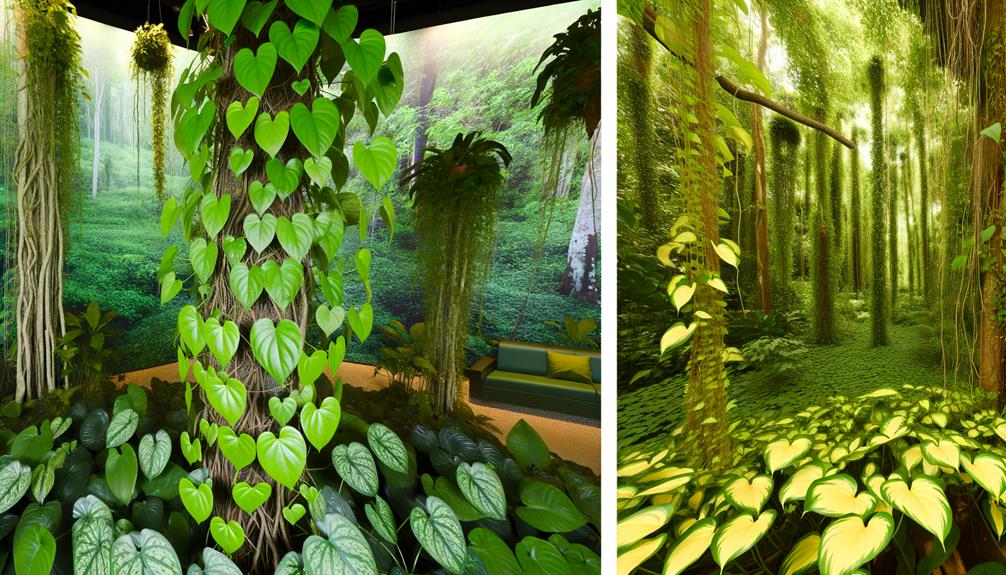
Heartleaf Philodendron (Philodendron hederaceum) and Pothos (Epipremnum aureum) both originate from the tropical rainforests of Central and South America, thriving in humid, shaded environments under the forest canopy. These aroids are climbers that utilize aerial roots to ascend trees and other structures, maximizing access to diffuse sunlight.
Hederaceum belongs to the family Araceae, while E. aureum is classified under the same family, yet occupies a separate genus. In their native habitats, both species contribute to the complex understory ecosystem, playing roles in moisture retention and nutrient cycling.
Adapted to low-light conditions, they exhibit high plasticity in their growth habits, allowing them to colonize a variety of microenvironments within the rainforest’s dense foliage.
Leaf Shape and Size
The Heartleaf Philodendron (Philodendron hederaceum) and Pothos (Epipremnum aureum) exhibit distinct morphological differences in leaf shape and size. Philodendron leaves are typically more heart-shaped and uniform, whereas Pothos leaves are more variegated and oval.
When it comes to growth patterns, Philodendron leaves generally reach a size of 2 to 4 inches, while Pothos leaves can grow up to 12 inches under ideal conditions.
Leaf Shape Differences
Philodendron leaves are typically heart-shaped and display a more uniform, smooth texture, whereas Pothos leaves tend to have an irregular, sometimes more elongated shape with a leathery texture.
The morphological distinctions between these two genera are essential for accurate identification and classification.
Heartleaf Philodendron (Philodendron hederaceum):
- Exhibits a cordate (heart-shaped) leaf structure.
- Features a smooth, consistent surface texture.
Pothos (Epipremnum aureum):
- Presents an ovate to lanceolate (elongated) leaf morphology.
- Characterized by a tougher, more leathery texture.
These differences in leaf architecture reflect variations in their respective adaptive strategies, further delineating their taxonomic positions within the Araceae family.
Understanding these distinctions aids in proper horticultural management and aesthetic application.
Typical Leaf Sizes
Leaf size variability between Philodendron hederaceum and Epipremnum aureum is a key factor in differentiating these species. Philodendron leaves typically measure between 2 to 4 inches in length, while Pothos leaves often extend from 4 to 12 inches.
Philodendron hederaceum exhibits ovate to heart-shaped leaves, providing a more delicate appearance compared to Epipremnum aureum. The latter presents larger, more robust leaves that are generally more leathery in texture.
Additionally, the venation pattern in Philodendron is often more subtle, whereas Pothos leaves display prominent, often yellow or white variegation. Accurate identification requires meticulous observation of these morphological characteristics, essential for botanists and horticulturists aiming to classify and cultivate these distinct species appropriately.
Growth Patterns
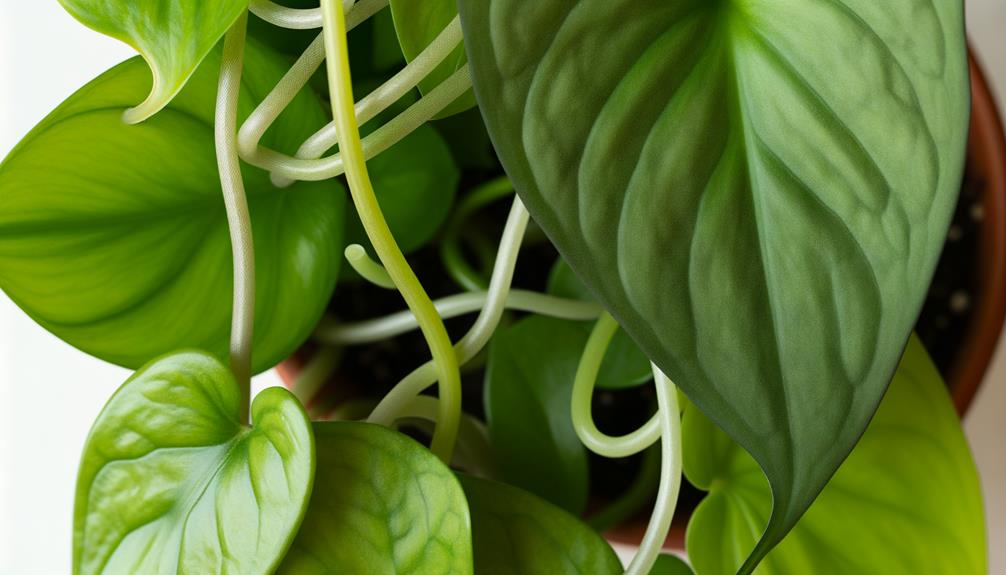
A key distinction in growth patterns between Heartleaf Philodendron (Philodendron hederaceum) and Pothos (Epipremnum aureum) lies in their respective vining behaviors and internodal lengths.
Heartleaf Philodendron exhibits a more consistent climbing tendency, utilizing aerial roots to adhere to surfaces, while Pothos tend to produce longer internodes, allowing for more extensive trailing. These differences influence the overall plant morphology and suitability for various indoor environments.
| Feature | Heartleaf Philodendron (P. hederaceum) | Pothos (E. aureum) |
|---|---|---|
| Vining Behavior | Climber | Trailer |
| Internodal Length | Short | Long |
| Aerial Root Presence | Frequent | Less Frequent |
| Growth Speed | Moderate | Fast |
| Light Preference | Low to Medium | Medium to High |
Understanding these growth patterns aids in selecting the appropriate plant for specific decorative or spatial requirements.
Stem Characteristics
Heartleaf Philodendron stems are typically more slender and flexible in comparison to the thicker, more robust stems of Pothos, which show a higher level of structural rigidity.
The Philodendron’s stems exhibit a delicate structure, defined by a smaller diameter and increased flexibility, allowing for easier handling and shaping in various growth patterns.
On the other hand, Pothos stems are noticeably thicker, showing more lignification, which provides improved mechanical strength and longevity.
- Philodendron stems: Slender, flexible, smaller diameter, less lignified
- Pothos stems: Thicker, robust, greater lignification, higher mechanical strength
- Stem coloration: Philodendron tends towards a consistent green hue, while Pothos may display variegation
- Stem node spacing: Philodendron typically has shorter internodal distances compared to Pothos
These distinct stem characteristics have a significant impact on their respective horticultural applications and care requirements.
Aerial Roots
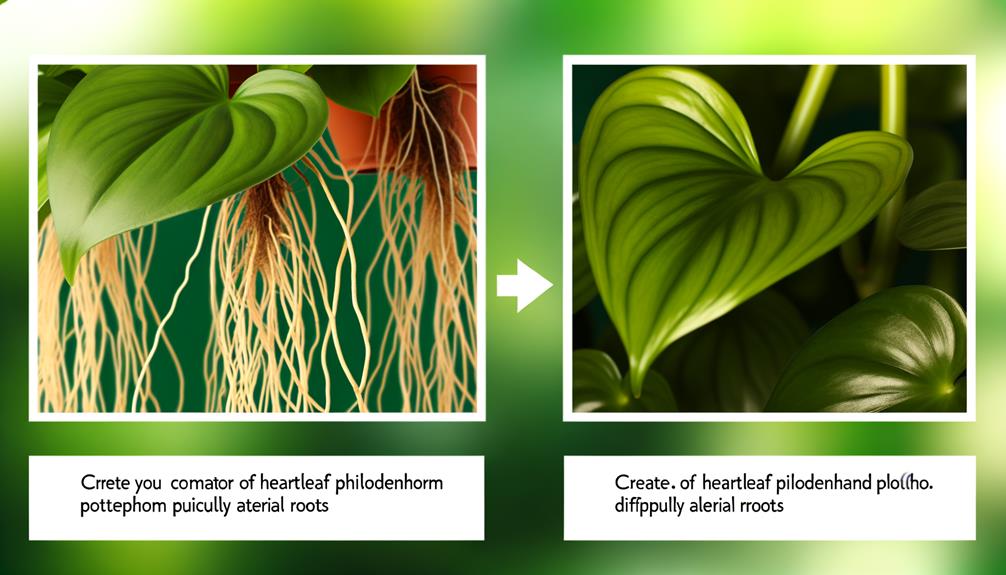
Aerial roots serve distinct functions in both Heartleaf Philodendron (Philodendron hederaceum) and Pothos (Epipremnum aureum), influencing their growth and structural adaptations.
In Philodendron hederaceum, aerial roots are primarily involved in nutrient absorption and attachment, whereas Epipremnum aureum exhibits robust aerial root formation that aids in both support and climbing.
These morphological differences in aerial root development are essential for understanding their respective ecological niches and care requirements in cultivation.
Root Formation Differences
In examining the root formation differences between Philodendron hederaceum and Epipremnum aureum, one observes that the former develops multiple slender aerial roots primarily for moisture absorption, while the latter generates fewer but more robust aerial roots geared towards structural support and nutrient acquisition.
Philodendron hederaceum’s aerial roots are typically fine and elongated, adapting to its need for high humidity environments. These roots function efficiently in absorbing moisture from the air.
Conversely, Epipremnum aureum’s aerial roots are thicker and less numerous, optimized for clinging to surfaces and facilitating nutrient uptake from organic debris.
This morphological distinction is indicative of their respective evolutionary adaptations, with Philodendron favoring epiphytic moisture collection and Pothos prioritizing anchorage and nutrient scavenging.
Support and Climbing
Philodendron hederaceum and Epipremnum aureum exhibit distinct climbing mechanisms, leveraging their respective aerial root structures to secure themselves onto vertical surfaces and facilitate upward growth.
Philodendron hederaceum, commonly known as Heartleaf Philodendron, employs fine, hair-like roots that penetrate crevices, enhancing their grip on substrates.
Conversely, Epipremnum aureum, known as Pothos, utilizes robust, adhesive aerial roots that can attach to a wider range of surfaces.
These physiological adaptations enable both species to thrive in diverse environments, from tropical forests to indoor settings.
Philodendron hederaceum:
- Fine, hair-like aerial roots
- Enhanced penetration of crevices
Epipremnum aureum:
- Robust, adhesive aerial roots
- Versatile attachment to various surfaces
These mechanisms underscore their evolutionary adaptations for efficient vertical growth.
Light Requirements
Both Heartleaf Philodendron (Philodendron hederaceum) and Pothos (Epipremnum aureum) thrive in bright, indirect light, although they can tolerate lower light conditions.
These species exhibit a high degree of phenotypic plasticity, enabling them to adapt to less-than-ideal light environments. Heartleaf Philodendron is particularly adept at photosynthesis under dappled shade, reflecting its native understory habitat.
Pothos, conversely, demonstrates remarkable resilience in low-light areas, owing to its robust chlorophyll content. However, prolonged exposure to insufficient light may result in etiolation, characterized by elongated stems and sparse foliage.
Optimal growth and variegation are best achieved under filtered sunlight or artificial grow lights with a balanced spectral output. Therefore, while both plants are versatile, providing adequate light levels ensures their physiological and aesthetic well-being.
Watering Needs
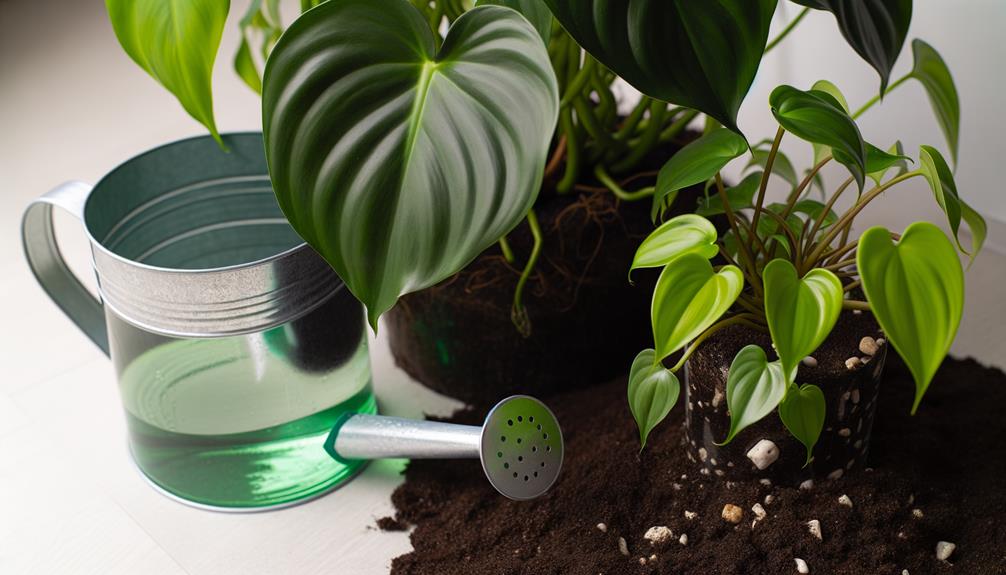
In examining the watering needs of Heartleaf Philodendron (Philodendron hederaceum) and Pothos (Epipremnum aureum), it is critical to take into account both the frequency of watering and best soil moisture levels.
Heartleaf Philodendron typically requires more consistent moisture, favoring evenly moist but not waterlogged soil.
Conversely, Pothos exhibits greater drought tolerance, necessitating infrequent watering and allowing the soil to dry out partially between waterings.
Frequency of Watering
Understanding the watering needs of Heartleaf Philodendron and Pothos is crucial for maintaining ideal plant health and preventing issues such as root rot or dehydration.
Heartleaf Philodendron (Philodendron hederaceum) generally prefers consistently moist soil, yet it can tolerate brief periods of dryness.
Conversely, Pothos (Epipremnum aureum) thrives with a more irregular watering schedule, favoring thorough watering followed by allowing the soil to dry out completely.
- Heartleaf Philodendron: Water when the top inch of soil is dry.
- Pothos: Water when the top 2-3 inches of soil are dry.
- Frequency: Heartleaf Philodendron typically requires more frequent watering than Pothos.
- Environmental Considerations: Adjust frequency based on humidity, light conditions, and season.
Understanding these nuances ensures prime care for each plant species.
Soil Moisture Levels
Soil moisture levels are crucial for distinguishing the specific watering needs of Heartleaf Philodendron (Philodendron hederaceum) and Pothos (Epipremnum aureum).
The Heartleaf Philodendron thrives in consistently moist, well-draining soil, requiring a balance that prevents waterlogging yet retains adequate moisture. This species exhibits prime growth when the top 1-2 inches of soil are allowed to dry slightly between waterings.
Conversely, Pothos prefers a more drought-tolerant approach, flourishing when the soil dries out more thoroughly between waterings. It is advisable to permit the top 2-3 inches of soil to become dry before rehydrating.
Understanding these distinct moisture requirements is essential to prevent root rot or desiccation, thereby ensuring the health and strength of each plant species.
Soil Preferences
Ideal soil conditions for heartleaf philodendron and pothos require well-draining, nutrient-rich substrates that encourage healthy root growth and prevent waterlogging.
Both species thrive in a growing medium that balances aeration and moisture retention, vital for avoiding root rot and optimizing nutrient uptake. A preferred soil mix typically comprises organic matter and well-aerated components that facilitate oxygen availability to the roots.
- Peat moss enhances water retention while maintaining adequate drainage.
- Perlite promotes aeration and prevents compaction of the soil.
- Composted bark provides organic nutrients and improves soil texture.
- Coco coir offers balanced moisture retention and aeration properties.
These components collectively create an ideal environment for the growth and sustenance of heartleaf philodendron and pothos.
Fertilizing Schedules
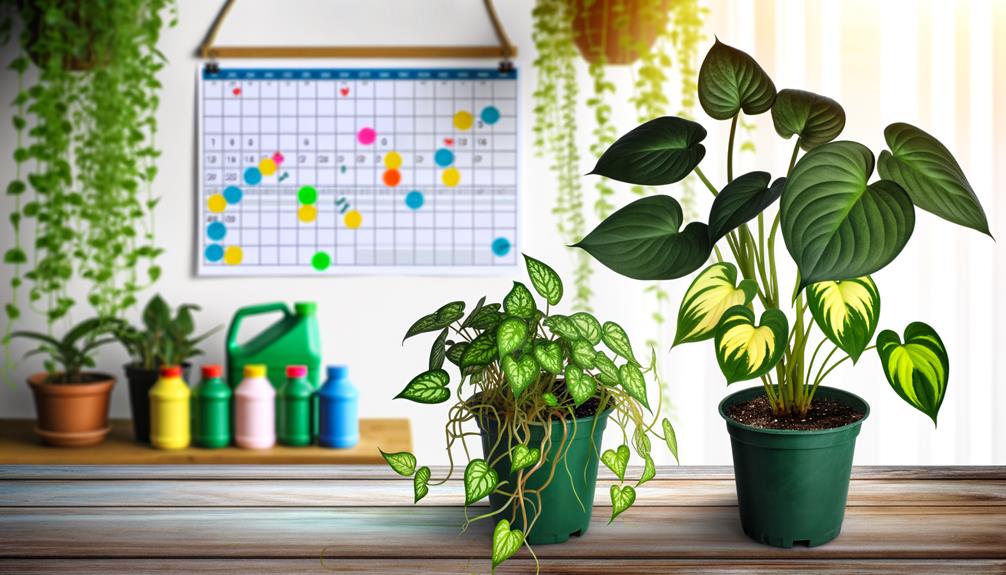
Proper fertilization is imperative for the ideal growth of heartleaf philodendron and pothos, complementing their soil needs by providing essential nutrients at specific intervals.
For both species, a balanced, water-soluble fertilizer with an N-P-K ratio of 20-20-20 is recommended. Fertilization should occur bi-monthly during the active growing season, typically spring through early autumn.
For heartleaf philodendron (Philodendron hederaceum), dilute the fertilizer to half strength to prevent root burn. Conversely, pothos (Epipremnum aureum) can tolerate full-strength applications but should still be monitored for signs of nutrient excess.
During dormancy in winter, reduce fertilization frequency to once every 2-3 months to prevent nutrient accumulation and maintain overall plant health.
Common Pests
Notwithstanding their resilience, heartleaf philodendron and pothos are susceptible to a variety of common pests, including spider mites, aphids, and mealybugs. These pests can cause significant damage by feeding on the plant’s sap, leading to symptoms such as chlorosis, stunted growth, and general plant decline.
- Spider Mites (Tetranychidae): Microscopic arachnids that cause discoloration and webbing.
- Aphids (Aphidoidea): Small insects that excrete honeydew, promoting sooty mold growth.
- Mealybugs (Pseudococcidae): Cotton-like pests that weaken plants by sucking sap.
- Scale Insects (Coccoidea): Hard-shelled pests that adhere to stems and leaves, extracting nutrients.
Effective pest management involves regular inspection, maintaining ideal humidity levels, and employing appropriate insecticidal treatments to mitigate infestations.
Propagation Methods
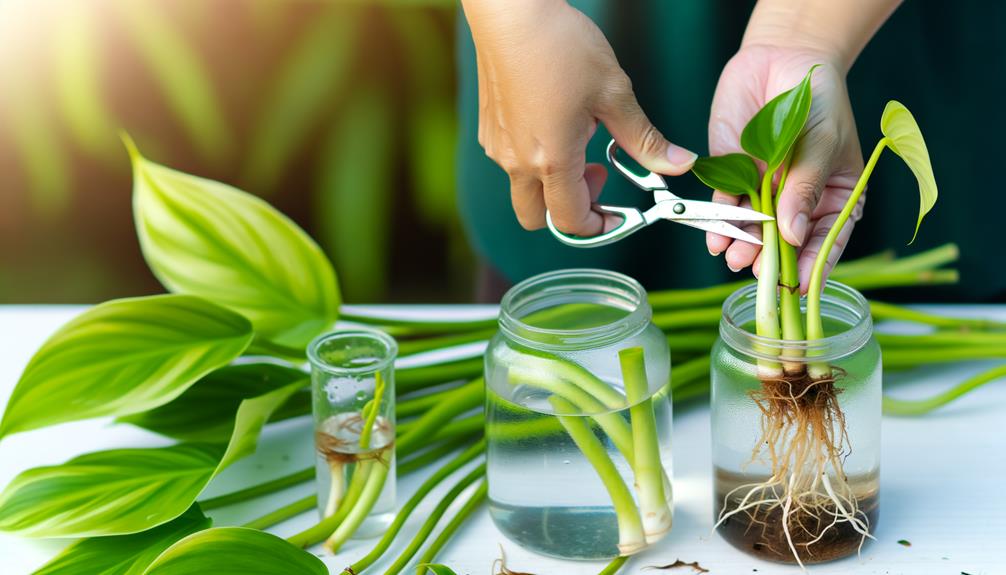
Propagation of heartleaf philodendron (Philodendron hederaceum) and pothos (Epipremnum aureum) primarily involves asexual methods, such as stem cuttings and division, to guarantee genetic consistency and rapid growth. Stem cuttings are taken at a node, ensuring the presence of at least one leaf and aerial root.
These cuttings are then placed in water or moist soil to initiate root development. Division is a less common method, involving the separation of the root mass into distinct sections, each containing viable stems and roots.
Below is a comparison of the propagation techniques for both species:
| Propagation Technique | Heartleaf Philodendron | Pothos |
|---|---|---|
| Stem Cuttings | Common | Common |
| Division | Rare | Rare |
| Rooting Medium | Water/Soil | Water/Soil |
| Success Rate | High | High |
Decor and Aesthetic
While propagation methods guarantee the proliferation of heartleaf philodendron and pothos, their distinctive aesthetic attributes greatly enhance their value as ornamental houseplants.
Heartleaf philodendron (Philodendron hederaceum) features heart-shaped, matte green leaves with a smooth texture and trailing growth habit, making it ideal for hanging baskets or climbing structures.
In contrast, Pothos (Epipremnum aureum) exhibits glossy, variegated leaves with golden or white streaks and a robust vining nature, suitable for both hanging displays and ground cover.
Key visual distinctions include:
- Leaf Texture: Heartleaf philodendron’s matte finish vs. pothos’s glossy sheen.
- Variegation: Pothos often displays variegated patterns, unlike the uniformly green philodendron.
- Growth Habit: Both are vining, but pothos has a more vigorous growth rate.
- Leaf Shape: Heartleaf philodendron’s leaves are more uniformly heart-shaped compared to pothos.
Conclusion
To wrap up, the distinctions between heartleaf philodendron and pothos, though subtle, are crucial to their unique taxonomies and cultivation requirements.
The heartleaf philodendron, with its delicate stem structures and specific leaf morphology, contrasts with the robust and versatile growth patterns of the pothos.
One might joke that these plants, despite their botanical nuances, are often mistaken for each other by the casual observer—a proof of nature’s inclination for playful deception and the gardener’s perpetual challenge.

